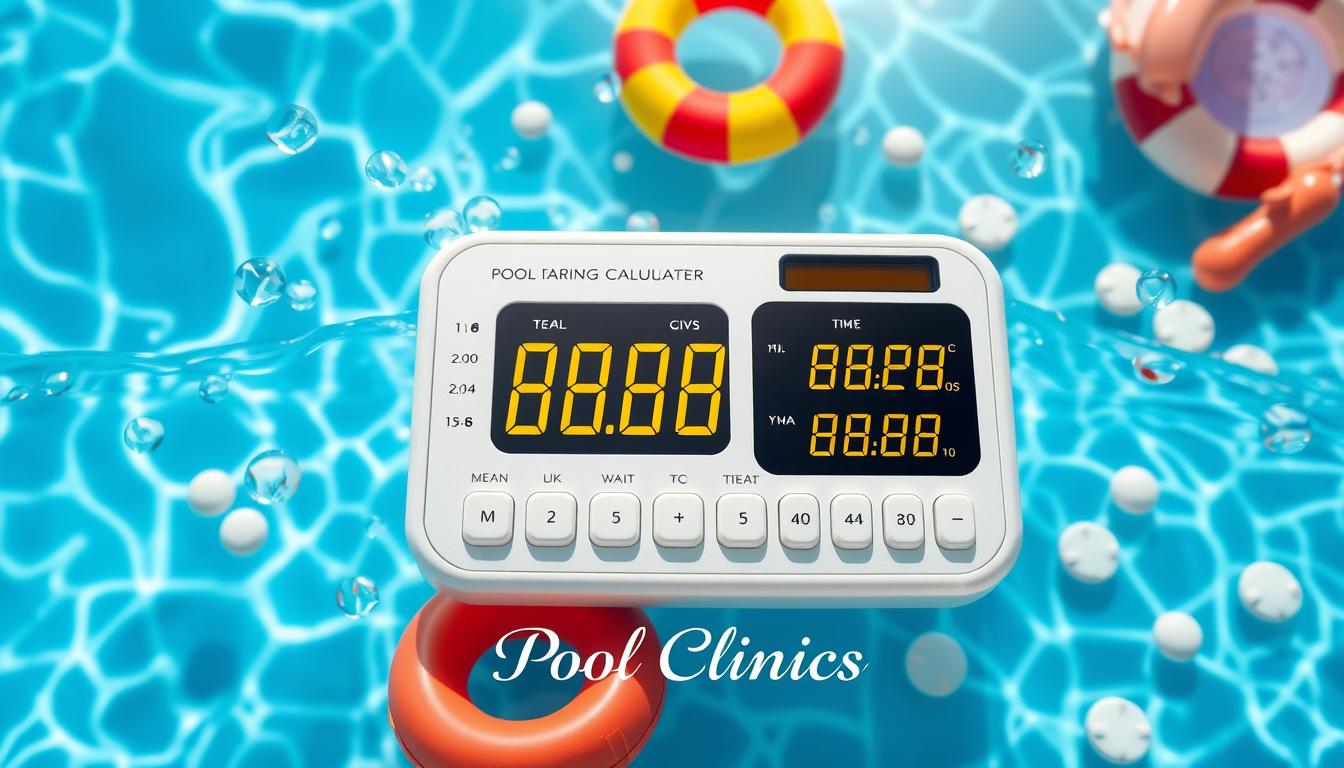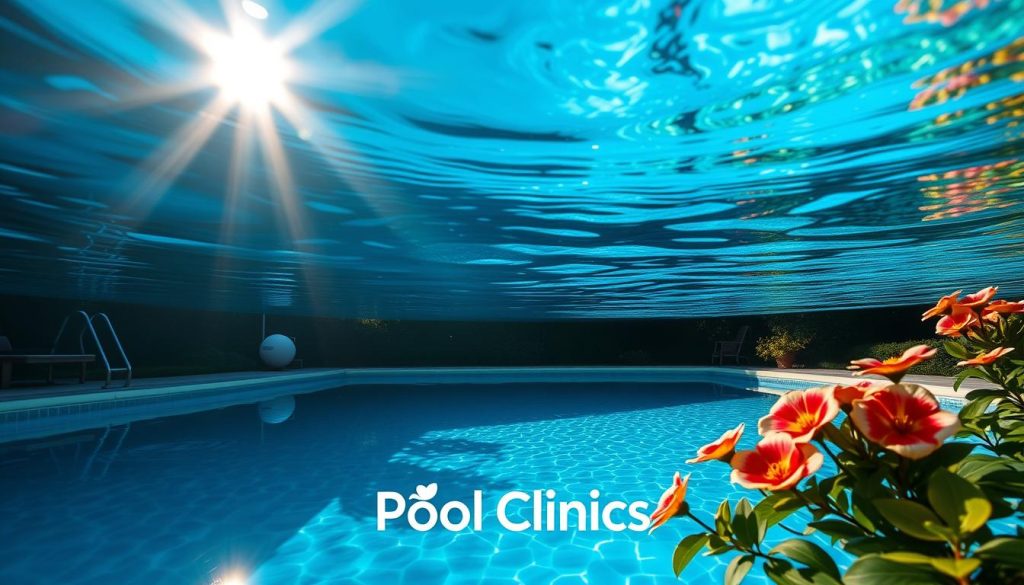
Tired of guessing how much chlorine to add to your pool? Our pool chlorine calculator takes the guesswork out of dosing. It helps you maintain proper chlorine levels for a safe, clean swimming pool.
A pool chemical calculator is crucial for ideal chlorine levels. It considers your pool’s volume, chlorine type, and current and target free chlorine levels. This tool provides precise recommendations for keeping your pool water safe and clean.
Your pool’s volume is key in determining the right chlorine amount. A larger pool needs more chemicals than a smaller one. Check your pool’s build schematics or ask the builder for accurate volume information.
If these resources aren’t available, use a pool volume calculator. It will help estimate your pool’s capacity accurately.
Our pool water chlorination calculator helps maintain proper chlorine levels consistently. It ensures a safe swimming experience for you and your family. It also helps extend the life of your pool and equipment.
Key Takeaways
- A pool chlorine calculator helps determine the right amount of chlorine for your pool, ensuring proper sanitization and water quality.
- The chlorine dosage calculator considers factors such as pool volume, type of chlorine, and current and target free chlorine levels.
- Accurately measuring your pool’s volume is crucial for determining the correct amount of chlorine needed.
- Using a pool chemical calculator takes the guesswork out of maintaining ideal chlorine levels, making pool care easier and more efficient.
- Consistently maintaining proper chlorine levels with the help of a chlorine ppm calculator ensures a safe and enjoyable swimming experience while prolonging the life of your pool and its equipment.
Understanding Pool Chlorine Levels
Proper chlorine levels are vital for a safe swimming pool. Pool owners must know the ideal range and factors affecting chlorine demand. This knowledge helps keep pools sanitized and clear.

Ideal Chlorine Range for Swimming Pools
The ideal free chlorine level for pools is 1.0 to 3.0 parts per million (ppm). A 3 ppm level is optimal for eliminating bacteria and preventing algae growth. Regular testing is crucial, especially during peak usage times.
If chlorine drops below 1 ppm, add more to the water. Use products like Zyax Chloro MAXX 90 Chlorine Granules or Zyax Pool Maxx Disinfectant. Don’t add chlorine if levels exceed 3 ppm. Let them decrease naturally.
Factors Affecting Chlorine Demand
Various factors can impact your pool’s chlorine demand. Understanding these helps adjust chlorine dosage for proper sanitation. Key factors include sunlight exposure, bather load, water temperature, and contaminants.
- Sunlight exposure: UV rays from the sun can break down chlorine, leading to lower levels.
- Bather load: The more swimmers in your pool, the higher the chlorine demand due to increased contaminants.
- Water temperature: Warmer water temperatures can cause chlorine to dissipate more quickly.
- Debris and contaminants: Leaves, dirt, and other organic matter can consume chlorine, reducing its effectiveness.
To maintain sanitation, you may need to increase chlorine dosage or shock your pool. Shocking involves adding concentrated chlorine to quickly raise levels and remove contaminants.
| Product | Available Chlorine | Dosage (5K-gallon pool) | Dosage (30K-gallon pool) |
|---|---|---|---|
| Leslie’s 3″ Jumbo Tabs (Trichlor) | 90% | 1 tab | 6 tabs |
| Leslie’s Chlor Brite (Dichlor) | 55% | 1.5 oz. | 9 oz. |
| Leslie’s Power Powder Plus (Cal-Hypo) | 70% | 4.5 oz. | 27 oz. |
| Leslie’s Liquid Chlorine (Sodium Hypochlorite) | 12.50% | 5 fl. oz. | 31 oz. |
Knowing the ideal chlorine range helps maintain proper levels in swimming pools. Regular testing and adjusting chlorine dosage are key. Using the right pool care products ensures a safe and enjoyable swim for everyone.
Using a Pool Chlorine Calculator
Clean, safe pools need the right chlorine levels. A pool chlorine calculator helps you add the correct amount. It uses your pool’s volume and current chlorine levels.
We’ll explore how to use this tool. We’ll also discuss different chlorine types and measuring pool volume.
How Much Chlorine to Put in Pool Calculator
A pool chlorine calculator takes the guesswork out of chlorine dosing. You’ll need to know your pool’s volume and current chlorine levels. Input this data, and the calculator will provide the right dosage.
For a 20,000-gallon pool using chlorine granules, add 7 ounces to raise chlorine by 1 ppm. If using 3-inch tablets, add about 4 tablets for the same pool size.
Types of Chlorine for Pool Sanitation
Pool sanitation uses three common chlorine forms: granules, tablets, and liquid. Each type has pros and cons. Your choice depends on preference and pool size.
- Chlorine granules (dichlor): These are added directly to the water by broadcasting the granules over your pool’s surface.
- Chlorine tablets (trichlor): Available in 3-inch pucks or 1-inch tablets, these are added to a dispenser, such as a floater or automatic chlorinator.
- Liquid chlorine (sodium hypochlorite): Usually 10-12% chlorine by volume, liquid chlorine is less potent than granules or tablets and is unstabilized, meaning it doesn’t contain cyanuric acid.
| Pool Volume (gallons) | Chlorine Granules (dichlor) | 3-inch Chlorine Tablets (trichlor) | Liquid Chlorine (sodium hypochlorite) |
|---|---|---|---|
| 5,000 | 2-3 ounces | 1 tablet | 0.5 gallons |
| 10,000 | 4-6 ounces | 2 tablets | 1 gallon |
| 20,000 | 7 ounces | 4 tablets | 2 gallons |
| 30,000 | 10-12 ounces | 6 tablets | 3 gallons |
Measuring Your Pool’s Volume
Knowing your pool’s volume is key for accurate chlorine dosing. Check build schematics or ask the builder for this info. If unavailable, use a pool volume calculator for a good estimate.
Run your pump and filter before adding chlorine. This helps it circulate and dissolve properly. Using a calculator and understanding chlorine types ensures a clean, healthy pool.
Conclusion
Proper chlorine levels are vital for a safe swimming experience. The Chlorine/CYA ratio, typically 7.5%, keeps hypochlorous acid at effective levels. This active sanitizer eliminates pathogens and ensures clean water.
Regular testing of free chlorine and CYA levels is crucial. Follow the Chlorine/CYA chart and avoid high CYA concentrations. Balance other water parameters like pH, alkalinity, and calcium hardness.
Use a pool chlorine calculator to determine ideal chlorine levels. This tool helps maintain the right balance based on CYA concentration. Understanding pool chemistry allows for informed decisions about pool maintenance.
By following these guidelines, you’ll create a healthy aquatic environment. Your pool will be clean, clear, and inviting for all swimmers. Proper maintenance ensures enjoyable and safe swimming experiences.







